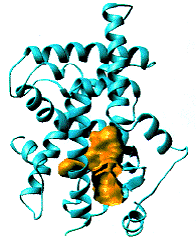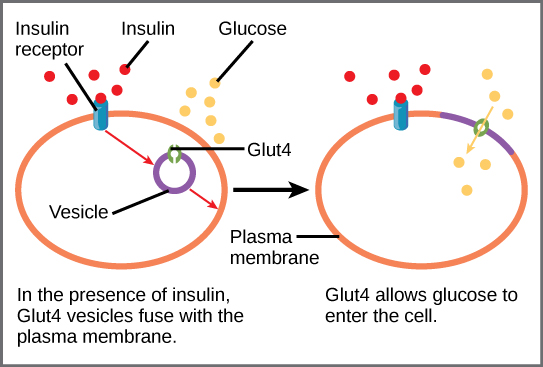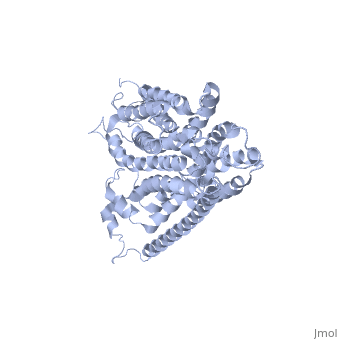Glucose Transporter Type 4 (GLUT4) is an insulin-regulated membrane protein responsible for decreasing blood glucose concentration found in both adipose tissues as well as striated muscle[1]. Activity of this protein is primarily regulated by the signal transduction pathway and several transcriptional factors found in the tissues where GLUT4 is located[2][3][4]. GLUT4 is responsible for returning blood glucose to a physiological concentration of 5-6mM after the ingestion of carbohydrates, as well as increasing the rate of glycogen synthesis in skeletal muscle following glycogen depleting exercise[5][6].

Reaction Mechanism

During periods in which insulin is low, GLUT4 is found in intracellular vesicles among adipose and muscle cells. When blood glucose increases and insulin spikes, insulin binds to insulin receptors on the plasma membrane. The insulin receptor’s tyrosine-kinase domain is activated by the binding of insulin. This activation starts a protein activation cascade leading to the translocation of GLUT4, starting with the phosphorylation of Insulin Receptor Substrate, which then binds PI-3 kinase. PI-3 kinase is responsible for the conversion of membrane lipid phosphatidylinositol 4,5-bisphosphate (PIP2) to phosphatidylinositol (3,4,5)-triphosphate (PIP3). PIP3 can then activate protein kinase B, which phosphorylates TBC1 domain family member 4 (TBC1D4). The phosphorylation of TBC1D4 allows for Rab protein to change from its GDP bound state to its GTP bound state. This stimulates translocation of GLUT4 to the plasma membrane.
Once translocation occurs and GLUT4 is inserted into the plasma membrane, glucose absorption in the cell is increased. Facilitated diffusion of glucose down its concentration gradient into the cell occurs. After entering the cell, glucose is phosphorylated in glucose-6-phosphate by hexokinase in most cells, and glucokinase in the liver. Glucose-6-phosphate is incapable of diffusing out of the cell, and it either enters glycolysis or is polymerized into glycogen[7].
Medical Relevance
Disruption of GLUT4 activity can affect insulin resistance as well as glucose tolerance. Decrease of GLUT4 activity leads to a sharp increase in plasma insulin concentration, as well as decreasing the rate of glucose uptake in muscle and fat cells [8]. Targeted GLUT4 disruption has been shown to lead to acute insulin resistance. This causes a much more gradual response to rising blood glucose levels, which in turn can induce hyperglycemia and diabetes [9].



